When to Replace Roof Shingles: 5 Warning Signs to Watch For
Most homeowners don’t think about their roof until there’s a problem. Spotting the signs of roof damage early can save you thousands in repairs. The average asphalt shingle roof needs replacement every 15-25 years, but severe weather, poor installation, or low-quality materials can significantly reduce this lifespan. After reading this article, you will learn when to replace roof shingles by identifying five easy warning signs.
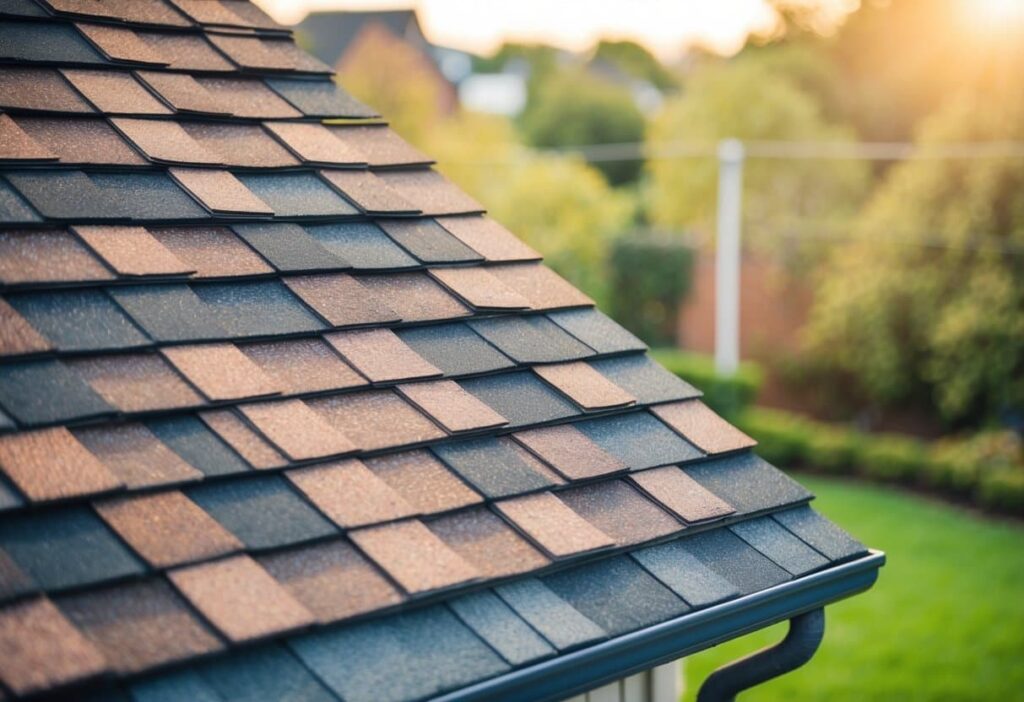
Studies show that waiting too long to replace damaged shingles often leads to structural damage and interior water problems. Look for curling edges, missing granules, or shingles that have cracked or gone missing entirely. These are clear indicators that your roof may need attention soon.
Professional roof inspections every 1-3 years can help identify problems before they become serious. Many Canadian roofers offer free inspections and can spot damage that’s not visible from the ground, giving you more accurate information about when to schedule that replacement.
Top Signs Your Shingles Need to Be Replaced
Roof shingles don’t last forever. Knowing when to replace them can save homeowners from costly water damage and structural issues.
Bald spots on your roof are a clear warning sign. These areas where shingles have completely lost their granules leave your roof vulnerable to the elements.
Curling shingles indicate age and weathering. When edges turn upward (cupping) or middle sections rise (clawing), your roof’s protective barrier is compromised.
Missing granules often appear in your gutters or downspouts. This granule loss exposes the asphalt to harmful UV rays, accelerating deterioration.
Look for dark streaks across your roof surface. These unsightly marks typically signal algae growth, which can gradually eat away at shingle material.
Moss growth might seem harmless or even charming, but it traps moisture against your roof. In Canadian winters, this moisture freezes and expands, forcing shingles apart.
After severe weather events, check for storm damage. High winds can tear shingles loose, while hail leaves distinct impact marks that compromise waterproofing.
Age remains a reliable indicator. Most asphalt shingles last 15-25 years, depending on quality and climate conditions. If your roof approaches this age range, consider a professional inspection.
Consider this quick assessment guide:
| Warning Sign | Severity | Action Required |
| Bald spots | High | Immediate replacement |
| Curling edges | Medium-High | Plan replacement soon |
| Missing granules | Medium | Professional assessment |
| Dark streaks | Low-Medium | Cleaning or replacement |
| Moss growth | Medium | Removal and possible replacement |
| Storm damage | Varies | Immediate inspection |
How Long Do Asphalt Shingles Last in Ontario?
Asphalt shingles in Ontario typically last between 15-25 years, depending on several factors. Our harsh Canadian climate plays a significant role in determining roof longevity.
The freeze-thaw cycles of Ontario winters can be particularly tough on roofing materials. Snow accumulation, ice dams, and rapid temperature changes stress asphalt shingles over time.
Quality matters enormously. Basic three-tab shingles might only reach the lower end of that range, while premium architectural shingles often last the full 25 years or beyond.
Factors affecting asphalt shingle lifespan in Ontario:
- Installation quality
- Attic ventilation
- Roof pitch/slope
- Tree coverage (shade vs. sun exposure)
- Maintenance frequency
- Colour (darker shingles absorb more heat)
Compared to metal roofing, which can last 40-70 years in Ontario conditions, asphalt has a shorter lifespan. Metal shingles specifically offer about 30-45 years of service.
Proper installation makes all the difference. A poorly installed premium shingle won’t outlast a properly installed basic shingle. Professional installation ensures proper nail placement, underlayment application, and flashing details.
Regular maintenance can extend shingle life considerably. Clearing debris, fixing minor damage promptly, and checking after major storms all help preserve your roof’s integrity.
The investment difference between asphalt and metal is substantial. While metal costs more initially, its longer lifespan often provides better value over decades of ownership.
Repair or Replace? Making the Right Call
Determining whether to repair or completely replace your roof can save thousands of dollars when done correctly. The decision isn’t always straightforward, but several key factors can guide homeowners.
Age matters significantly. Asphalt shingles typically last 20-25 years at the higher end of the spectrum. If your roof is approaching this age with multiple problems, replacement often makes more financial sense than repeated repairs.
Missing or damaged shingles in small areas can usually be repaired. However, when damage affects more than 30% of the roof, replacement becomes the more cost-effective solution.
Look for these warning signs that suggest replacement rather than repair:
- Curling or buckling shingles
- Bald spots where granules have worn away
- Daylight is visible through the roof boards
- Sagging roof deck
- Moss or algae growth that won’t clear with cleaning
The extent of water damage provides crucial information. Small, isolated leaks can often be repaired, while widespread moisture issues generally indicate systemic failure requiring full replacement.
Sometimes a partial replacement works well for sectional damage. This approach costs less than a full replacement while addressing more extensive problems than simple repairs can fix.
Quality roof repairs from professional contractors can extend roof life by 5-10 years when problems are caught early. Regular inspections help identify issues before they become severe.
What Happens If You Wait Too Long
Delaying roof shingle replacement can lead to serious problems for homeowners. When shingles deteriorate beyond their useful life, your home becomes vulnerable to water damage.
Water seepage is the most immediate concern. Damaged shingles allow moisture to penetrate your attic and walls, creating perfect conditions for mould growth.
Warning Signs That Can’t Be Ignored:
- Ceiling stains and discoloration
- Increased energy bills
- Mould or mildew smell indoors
- Sagging roof deck
- Granules in gutters
The repair costs climb dramatically once water damage begins. What might have been a straightforward new roof installation can transform into a complex structural repair project.
Structural damage becomes inevitable with prolonged exposure. Your roof’s decking—the wooden layer beneath the shingles—will rot and weaken when constantly wet.
Insurance complications may arise too. Many policies won’t cover damage resulting from neglected maintenance, leaving homeowners with the full financial burden.
Wildlife intrusions become more common with deteriorating roofs. Squirrels, raccoons, and birds can exploit weakened areas to make homes in your attic.
The longer you postpone replacement, the more extensive the eventual work becomes. A simple shingle replacement can evolve into needing new decking, insulation, and even interior repairs.
Winter presents additional risks for compromised roofs. Ice dams form more easily on damaged roofs, forcing melted snow under shingles and into your home.
The Best Time of Year to Replace Roof Shingles in Ontario
In Ontario, the ideal time for roof replacement falls between late spring and early fall. The sweet spot typically runs from May to October when temperatures are moderate and the weather is more predictable.
Summer offers long days and generally dry conditions, giving roofers more working hours. However, July and August can bring extreme heat that softens shingles and makes them vulnerable to damage during installation.
Fall Advantages:
- Cooler temperatures (15-20°C)
- Less humidity
- Ideal conditions for proper shingle sealing
- Preparation before winter storms
The fall season provides perfect weather conditions for asphalt shingles to properly seal before winter arrives. September is particularly excellent as temperatures remain stable without summer’s scorching heat.
Weather Consideration Chart:
| Season | Pros | Cons |
| Spring | Moderate temps, contractor availability | Rain delays, wet conditions |
| Summer | Long daylight hours, dry periods | Extreme heat, busy contractor schedules |
| Fall | Perfect sealing temps, pre-winter timing | Potential contractor backlog |
| Winter | Lower pricing, availability | Cold temp issues, snow delays |
Many homeowners wait too long and try to schedule in late fall. Book your roof replacement in early fall to avoid the rush and ensure completion before the first snowfall.
Rain and moisture can delay installations, so planning around Ontario’s typically drier periods is crucial for a smooth project.
What to Expect During Roof Replacement
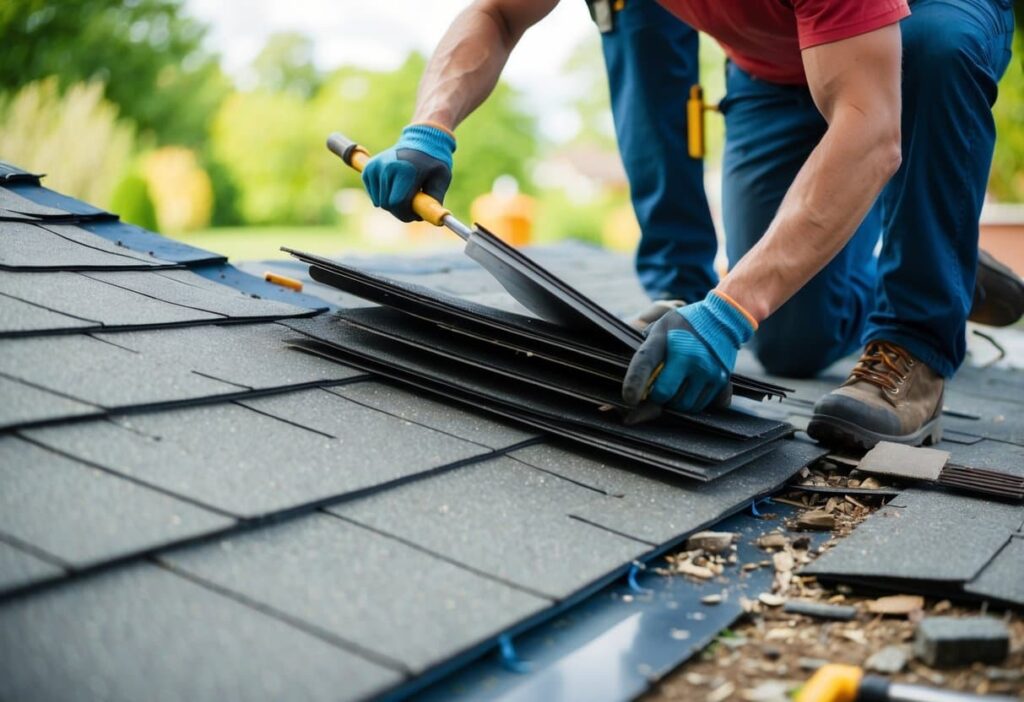
Roof replacement transforms your home but creates temporary disruption. Most projects take 2-5 days depending on roof size, weather conditions, and complexity.
The process begins with material delivery. Expect a large truck to deliver shingles, underlayment, and other roofing materials to your property 1-2 days before work starts.
On day one, crews will arrive early—typically between 7-8 AM. They’ll protect your landscaping and property with tarps before removing old shingles.
The Typical Roof Replacement Schedule:
- Day 1: Removal of old roofing materials and inspection of roof deck
- Day 2-3: Installation of underlayment and new shingles
- Final day: Clean-up and inspection
Noise levels will be significant during the project. The constant hammering and worker movement makes working from home challenging.
Weather plays a crucial role in scheduling. Rain or extreme temperatures may delay your project. Reputable contractors monitor forecasts closely to ensure optimal installation conditions.
The crew will conduct thorough clean-up using magnetic tools to collect stray nails and debris. Quality contractors perform multiple sweeps to protect your family and vehicles.
A final inspection completes the process. Your contractor should walk you through the finished work and address any concerns before considering the job complete.
How Much Does It Cost to Replace Shingles in Ontario?

Replacing roof shingles in Ontario typically costs between $3.25 to $6.50 per square foot. For an average 2,000 square foot roof, homeowners can expect to pay $6,500 to $13,000.
Several factors influence the final price tag of your roofing project:
Material Quality Affects Cost:
- Basic 3-tab shingles: $3.25-$4.00 per square foot
- Architectural shingles: $4.25-$5.75 per square foot
- Premium designer shingles: $5.50-$6.50+ per square foot
The complexity of your roof structure plays a significant role, too. Steeper pitches, multiple levels, and challenging access points can increase labour costs by 15-25%.
Location Matters: Prices vary across Ontario. Toronto and the GTA tend to command higher rates than rural areas, sometimes by 10-15%.
The season might affect your budget as well. Winter installations often cost more due to challenging conditions, while spring and fall typically offer more competitive pricing.
Permits and disposal fees add roughly $300-$600 to most projects. These administrative costs are unavoidable but represent a small portion of the total investment.
Additional Considerations:
- Roof deck repairs: $70-$100 per sheet of plywood
- Upgrading ventilation: $300-$600
- Enhanced underlayment: $0.20-$0.50 extra per square foot
Most quality installations come with labour warranties of 5-10 years and manufacturer material warranties ranging from 25 years to lifetime coverage.
Why Homeowners Choose CD Roofing & Construction Ltd.
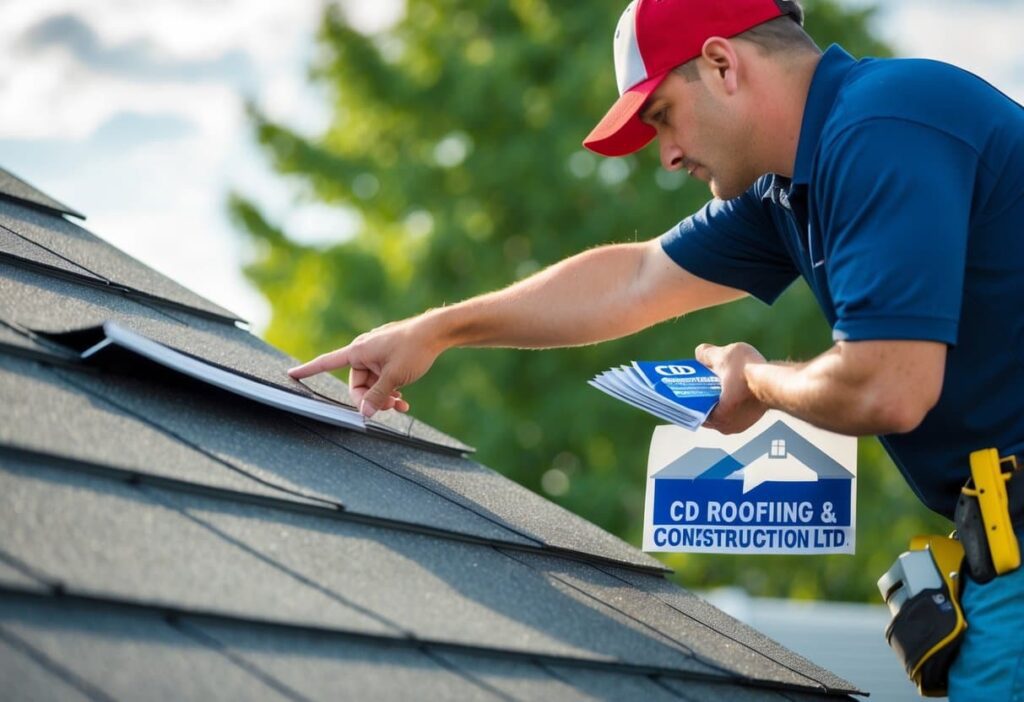
CD Roofing & Construction Ltd. has earned a stellar reputation across Canada for exceptional roofing services. Their team of certified professionals brings decades of combined experience to every project, large or small.
Quality materials set this company apart from competitors. They never cut corners, using only premium shingles and roofing components that withstand harsh Canadian weather conditions.
Homeowners appreciate our transparent pricing model. No hidden fees or surprise costs appear after project completion—what we quote is what customers pay.
Customer satisfaction is paramount at CD Roofing. Their 98% satisfaction rating speaks volumes about our commitment to excellence.
Our company offers these key benefits:
- Free, detailed inspections
- Written estimates with clear timelines
- Licensed and insured technicians
- 15-year workmanship warranty
- Emergency repair services
Punctual service means projects finish on schedule. This reliability has earned us loyal customers who recommend us to friends and family.
CD Roofing stays current with industry advancements. We regularly update our techniques and tools to provide cutting-edge solutions for modern homes.
Local knowledge matters in roofing. Our team understands regional weather patterns and building codes that affect Canadian homes specifically.
Unlike some contractors who vanish after installation, CD Roofing & Construction Ltd. provides ongoing support. We’re just a phone call away if questions or concerns arise post-completion.
Conclusion: Don’t Second-Guess Your Shingles
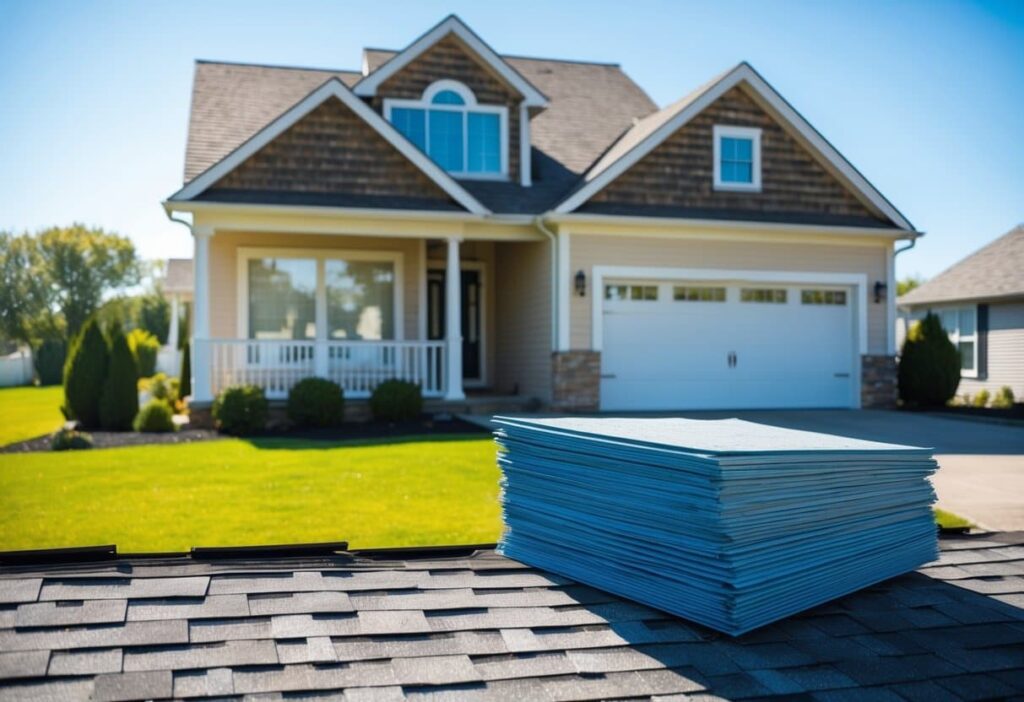
Replacing roof shingles at the right time saves homeowners money and stress. When shingles curl, crack, or lose granules, it’s time to call a professional.
Waiting too long can lead to leaks, structural damage, and more costly repairs. Smart homeowners inspect their roofs twice yearly and after major storms.
Remember these key signs:
- Shingles older than 20-25 years
- Curling or buckling edges
- Missing or damaged shingles
- Granules in gutters
- Visible sagging
A new roof does more than protect your home—it boosts your property’s curb appeal significantly. Fresh shingles can transform a tired-looking house into the neighbourhood standout.
Trust your instincts when you notice potential issues. If something looks wrong, it probably is. Professional roofers can confirm your suspicions with a proper inspection.
Investing in quality materials and professional installation pays dividends through longevity and performance. Premium shingles may cost more initially but often outlast budget options by many years.
Don’t put off necessary roof replacements. The small problems visible today can become major headaches tomorrow. Your home deserves proper protection from the elements.
Frequently Asked Questions
Homeowners often have important questions about their roofs that need clear answers. Here’s helpful information about roof replacements that might address your concerns.
How can you tell if your roof needs replacing?
Look for curled or missing shingles on your roof. These are key warning signs that shouldn’t be ignored.
Water stains on your ceiling or walls often mean your roof has failed in some area. Even small stains can signal bigger problems.
If your roof is over 20 years old, it’s wise to have it inspected regardless of its appearance. Age is a reliable indicator of when replacement might be needed.
What are the signs that indicate a roof’s shingles have reached the end of their lifespan?
Granule loss is a tell-tale sign of aging shingles. Check your gutters and downspouts for black granular material.
Cracked, curled, or buckled shingles indicate exposure damage from years of harsh Canadian weather. These damaged shingles can no longer protect your home effectively.
Moss or algae growth might seem harmless, but these organisms can lift shingles and create water entry points. Extensive growth often means it’s time for new shingles.
Is it necessary to replace a roof even when it appears to be intact and leakage-free?
Yes, sometimes replacement is necessary despite no visible leaks. Structural issues can develop beneath seemingly intact shingles.
Preventative replacement can save thousands in potential water damage repairs. It’s better to replace a worn roof before leaks develop.
Energy efficiency suffers with older roofing materials. A new roof can significantly improve your home’s insulation and reduce heating costs.
What are the average lifespan expectations for asphalt shingles in Canadian climates?
Standard three-tab asphalt shingles typically last 15-20 years in Canadian weather. Our harsh winters and temperature swings reduce their lifespan compared to milder climates.
Architectural or dimensional shingles generally last 25-30 years. Their thicker construction withstands our climate better.
Premium shingles with enhanced weather resistance can last 30-35 years with proper maintenance. These are worth considering for long-term value.
What financial options are available for homeowners who need a roof replacement but face budget constraints?
Home improvement loans specifically designed for roofing projects are available from many Canadian financial institutions. These often have competitive interest rates.
CD Rooding & Construction Ltd. offers payment plans that allow you to spread costs over several months or years. Ask about our no-interest periods to see if you qualify.
Government rebates and energy efficiency programs sometimes apply to roof replacements. Check with local and provincial authorities about current programs.
During the roof replacement process, is it recommended for residents to stay in their homes?
Most families can safely remain at home during roof replacement. The work primarily happens outside your living space.
Noise levels will be significant during working hours. Plan important calls or meetings elsewhere if you work from home.
Pets might become stressed by the unusual activity and noise. Consider arranging alternative care for sensitive animals during peak construction days.
Best Time To Replace A Roof In Durham Region
If you live in the Durham Region, Toronto or (anywhere in Southern Ontario for that matter) we’re all in the same boat when it comes to finding the best time to replace a roof. The summers are humid and can be extremely hot while the winters can be brutally cold. So when is the best time to replace your roof?
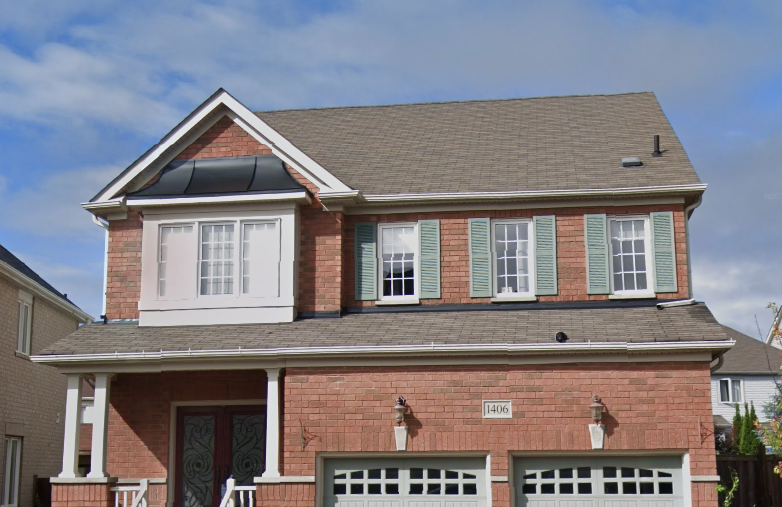
Truth be told, it’s not all about finding the best price on your investment. Sometimes there are many other factors that can affect the timing of your roof replacement. For instance, if your roof has suffered any damage from a storm, then it should be obvious that it requires immediate attention.
Best time to place a leaking roof was yesterday
It may sound like a no-brainer to some but you’d be surprised at how many homeowners fail to get their leaking roof repaired in time. A leaking roof can result in a cascade of unpleasant discoveries if left unattended.
The water from a leak can be the source of mildew and mold in your ceiling, walls, floors and carpet. It can do structural damage to the frame of your home and all of these things are much more costly to repair than getting it fixed ASAP.
Avoid the domino effect of damages that a leaky roof causes. The best time to get your leaky roof replaced was yesterday.
Spring season has its advantages
If your roof isn’t in need of immediate repair or replacement, you can approach your investment from a more practical standpoint. Keep in mind the second busiest season for Durham Region roofers is in the spring.
If we’ve had a particularly bad winter, there are a lot of people who will need to do some repairs or reroof their home entirely. Extreme temperatures can cause the most damage. It’s especially pronounced here because our seasons have such a wide range of extremes from hot to cold.
How does knowing this help you?
If you went into the winter season on the border of needing a roof replacement then it’s important for you to plan on booking your time for early spring with your roofing contractor. You won’t be the only one that’s going to need work done.
Spring tends to bring a lot of inclement weather, which can push back your scheduled date for roof replacement. If you’re planning correctly, your roof won’t be in a state of emergency and you’ll get the roof you need when you need it and at a decent price.
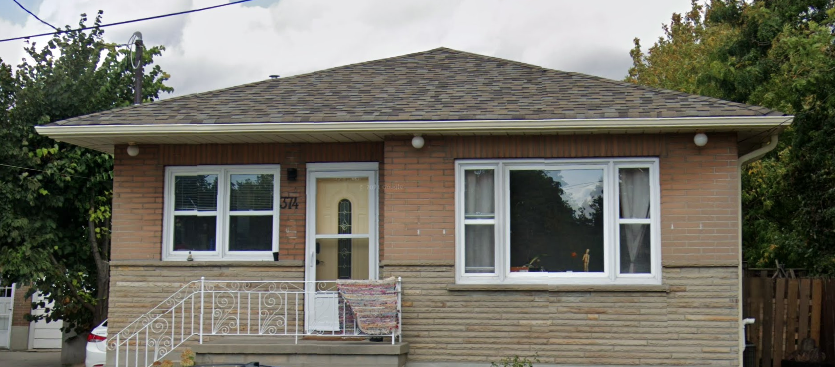
Summer months in Durham Region
While it may seem counterintuitive, the summer months are not the busiest season for roofing companies in Durham Region. In fact, most roofing contractors will experience a slight lull since families go away for the summer months and focus more of their attention on outdoor activities. For this reason, summer tends to be one of the best times to replace a roof.
Roofing companies are not usually booked too far out in the summer months. You can schedule a time for your roof replacement and generally count on the project going as planned.
Asphalt shingles become more difficult to work with in extreme heat, however, apart from those extremely hot days (or rainy days), every day is a good day for roofing.
Why the fall season is arguably the best time for roof replacement
It’s a fact that residential roofing in Oshawa, Whitby, Ajax, Toronto and the entire Durham region spikes every fall season. The fall is the busiest time of the year for roofing contractors. To schedule your roof replacement in the fall will require planning ahead and most likely a premium on the price you pay.
The reason fall is preferred is that people do not want to have any roofing issues during the coldest, most miserable winter months of the year. The extremely cold temperature will wreak havoc on any existing problems. The thought of going through some sort of roofing issue while it’s windy and snowy outside is enough to motivate homeowners to get their roofs in order before the dark and wintery weather begins.
Another reason why fall is the best time to replace a roof is that it has the most ideal climate for roofing. The moderate temperatures are the best for creating the most effective sealant. This also allows roofers to work more comfortably and efficiently. Less rain than summer and spring is another reason why fall is the best time to replace a roof.
Due to the high demand for a roof replacement in the fall, it is advisable to plan your roofing project well in advance. The earlier you book, the more likely you are to avoid paying a higher price. As fall goes into full swing and roofing contractors have less time to offer, making those time slots scarce and higher-priced.
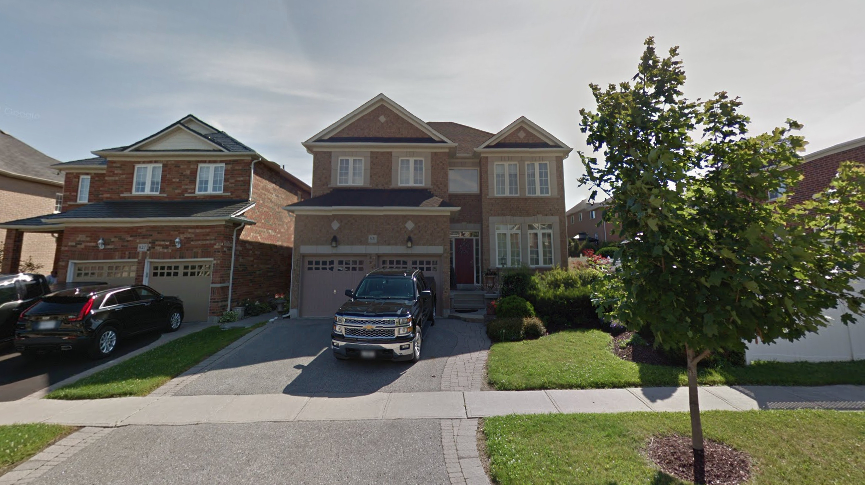
Don’t let winter fool you
Our beautiful Durham winter climate includes ice, snow, hail, sleet-all topped off with – 40C° temperatures. There is no doubt that winter has less than ideal conditions for roofing, however, it may surprise you to know that people still get their roof replaced.
Although it’s possible to install a shingle roof in the winter, it’s not recommended. It is much more difficult for the sealant to work effectively. There are also the increased hazards that roofers must face while installing a new roof.
While there seems to be a lot of downside to winter roofing, there are some advantages too. Since the winter season is the least busy of all seasons it becomes the best time to replace a roof in terms of scheduling and pricing.
Scheduling a roofing company to come to your place is easy. You’ll have a full team at your home that’s completely dedicated to completing your project in a timely manner.
It gets even better. Due to the fact that there aren’t as many residential roof replacements in the winter, you have more leverage to negotiate a better price.
As we mentioned before, shingle roofing isn’t advisable during the winter season, however standing seam metal roofs can be done with ease. We’re flat roof specialists-no matter what season it is, which makes winter less of a barrier to getting your roof replaced.
Plan your roof replacement carefully
Your home is one of your greatest assets and your roof is your protection from the elements all day and night. Don’t take your investment lightly. An asphalt shingle roof can last at least 15-20 years when it’s installed correctly with quality materials.
Find the best time to replace a roof based on the status of your current roof, the type of roof you’re planning on buying and any insight your roofing contractor can provide.
For any questions about how to plan your roofing project feel free to message our team or give us a call. We would be happy to help answer any questions and even happier to work with you on your next roofing project.
